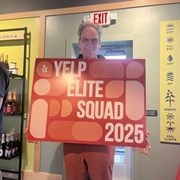Richard P.
Yelp
There's much to love about Indy's Harrison Center, a place I hadn't visited for quite some time until recently when I had the opportunity to stop by and check out a friend's exhibit during a First Friday event.
This entire corner has always intrigued me. The roots of the Harrison Center go all the way back to 1903 when the First Presbyterian congregation planted its fourth church home at the corner of 16th and Delaware. It was also the neighborhood housing the home of President Benjamin Harrison, a First Presbyterian elder and Sunday School teacher.
In 1970, the Presbyterian Metropolitan Center became a central location for Indy Presbyterian congregations to do community outreach. However, by the late 90's the building had fallen into disrepair and was acquired by local philanthropist Jeremy Efroymson. In 2000, he opened it as the Harrison Center for the Arts, a secular and for-profit arts center with tenants like VSA (Very Special Arts), Redeemer Presbyterian Church, Herron School of Art, The Nature Conservancy, and other artists.
A year later, a concert was held during Talbot Street Art Fair here and this would turn into the acclaimed Independent Music & Art Festival. Redeemer would acquire the building and in 2002 began operating as Harrison Center. By 2003, Harrison Center became a non-profit and its artist population grew. Within a couple years, it received Nuvo's Cultural Vision Award. In 2007, it housed the birth of Herron High School. Numerous other projects are started over the next several years and in 2017, Harrison Center for the Arts becomes simply Harrison Center.
Programs include First Fridays, Art Dish, IMAF, Community Engagement Drawing Sessions, Greatriarchs, Preenact Indy, Music, Video, Foodcon, Porch Party Indy, Place-Based Art, and the podcast "Music in Place."
The artist slate is full here, though Harrison Center has a variety of rooms that can be rented (not all are fully accessible - be sure to ask if that's needed!). There's even a gymnasium that's pretty awesome.
Facilities include the 1,100 square foot Harrison Gallery, the 1920s gymnasium, Speck Gallery, 24 artist studios (on 3 floors, again not all accessible). The artist studios are cool because many of the spaces were formerly parts of a church and retain that feeling.
You can buy art from the artists and some of it is available online. I'm currently eyeing a couple of pieces.
This is a wonderful space with a tremendous feeling filled with people who love art and artists. Art comes in a variety of prices, though these are all professional artists and prices reflect that.
While I'm tempted to take off a star simply because there are some accessibility issues, it has improved over time and generally I can typically get where I need to go. However, if you have certain places you're trying to get to it's definitely a question I'd ask first.
I recently returned for a First Friday event and fell in love with the space again. I look forward to returning in the near future.


























